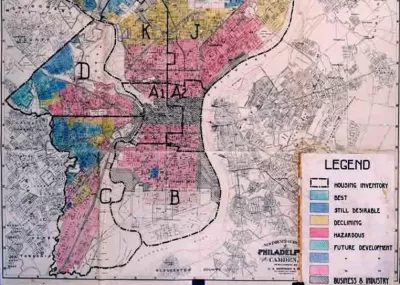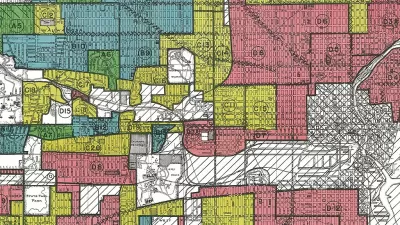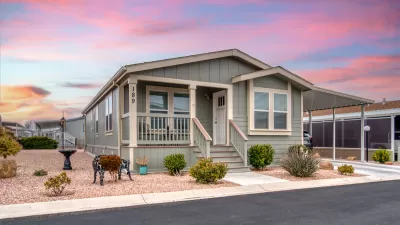New Deal agencies did engage in discriminatory lending practices–but not quite in the way we think.

Redlining–the practice of denying mortgages in certain neighborhoods based on maps created by the Home Owners Loan Corporation (HOLC) in the 1930s–has long been associated with disinvestment in Black neighborhoods. But according to Jake Blumgart, new research "complicates our understanding" of the practice and shows that redlining "did not quite work in the way that it is popularly understood."
In the 1930s, HOLC "drew up color-coded maps that evaluated neighborhoods based on their presumed prospects, with those believed to have the worst outlooks drawn in red." Until now, historians have interpreted this as a root cause of discriminatory lending. "But new research shows that the maps very probably did not guide private lenders or the Federal Housing Administration (FHA), which clearly engaged in racist lending practices all on their own. The HOLC, however, actually loaned widely in Black neighborhoods and other red-shaded areas."
As Blumgart writes, "Fishback and his co-authors are not arguing that racist mortgage practices did not occur. But they are trying to disentangle the policy of the two New Deal-era mortgage institutions, one of which engaged in heavily anti-Black practices (the FHA) and the other of which did not (HOLC)." Based on a sample of 16,000 loans in three cities, the researchers "found that in all three cities the HOLC refinanced many loans in neighborhoods coded red, with no evidence of discrimination against Black homeowners. The FHA, on the other hand, did not insure mortgages in the neighborhoods where Black homeowners lived and chiefly targeted newly constructed homes, which almost exclusively catered to whites, and those in wealthier neighborhoods."
This yields important lessons for today's policymakers, who can shape an agency's practices through the language of their legislation. "[T]he FHA was created to encourage 'economically sound”' loans that mostly translated into new construction — especially in the suburbs — which at that time almost entirely went to white families." Meanwhile, HOLC's legislation "is written to center struggling homeowners and to bail them out of a macroeconomic crisis they did not create," leading to different practices from the two agencies.
Amy Hillier, a researcher whose work showed that HOLC did, in fact, lend "heavily" in "redlined" areas, concludes that the new research validates her findings. "[H]ousing discrimination can happen in very subtle ways that are at least as insidious as very dramatic red maps with lines on them."
FULL STORY: Redlining Didn’t Happen Quite the Way We Thought It Did

Alabama: Trump Terminates Settlements for Black Communities Harmed By Raw Sewage
Trump deemed the landmark civil rights agreement “illegal DEI and environmental justice policy.”

Planetizen Federal Action Tracker
A weekly monitor of how Trump’s orders and actions are impacting planners and planning in America.

The 120 Year Old Tiny Home Villages That Sheltered San Francisco’s Earthquake Refugees
More than a century ago, San Francisco mobilized to house thousands of residents displaced by the 1906 earthquake. Could their strategy offer a model for the present?

LA’s Tree Emergency Goes Beyond Vandalism
After a vandal destroyed dozens of downtown LA trees, Mayor Karen Bass vowed to replace them. Days later, she slashed the city’s tree budget.

Sacramento Leads Nation With Bus-Mounted Bike Lane Enforcement Cameras
The city is the first to use its bus-mounted traffic enforcement system to cite drivers who park or drive in bike lanes.

Seattle Voters Approve Social Housing Referendum
Voters approved a corporate tax to fund the city’s housing authority despite an opposition campaign funded by Amazon and Microsoft.
Urban Design for Planners 1: Software Tools
This six-course series explores essential urban design concepts using open source software and equips planners with the tools they need to participate fully in the urban design process.
Planning for Universal Design
Learn the tools for implementing Universal Design in planning regulations.
Ada County Highway District
Clanton & Associates, Inc.
Jessamine County Fiscal Court
Institute for Housing and Urban Development Studies (IHS)
City of Grandview
Harvard GSD Executive Education
Toledo-Lucas County Plan Commissions
Salt Lake City
NYU Wagner Graduate School of Public Service





























